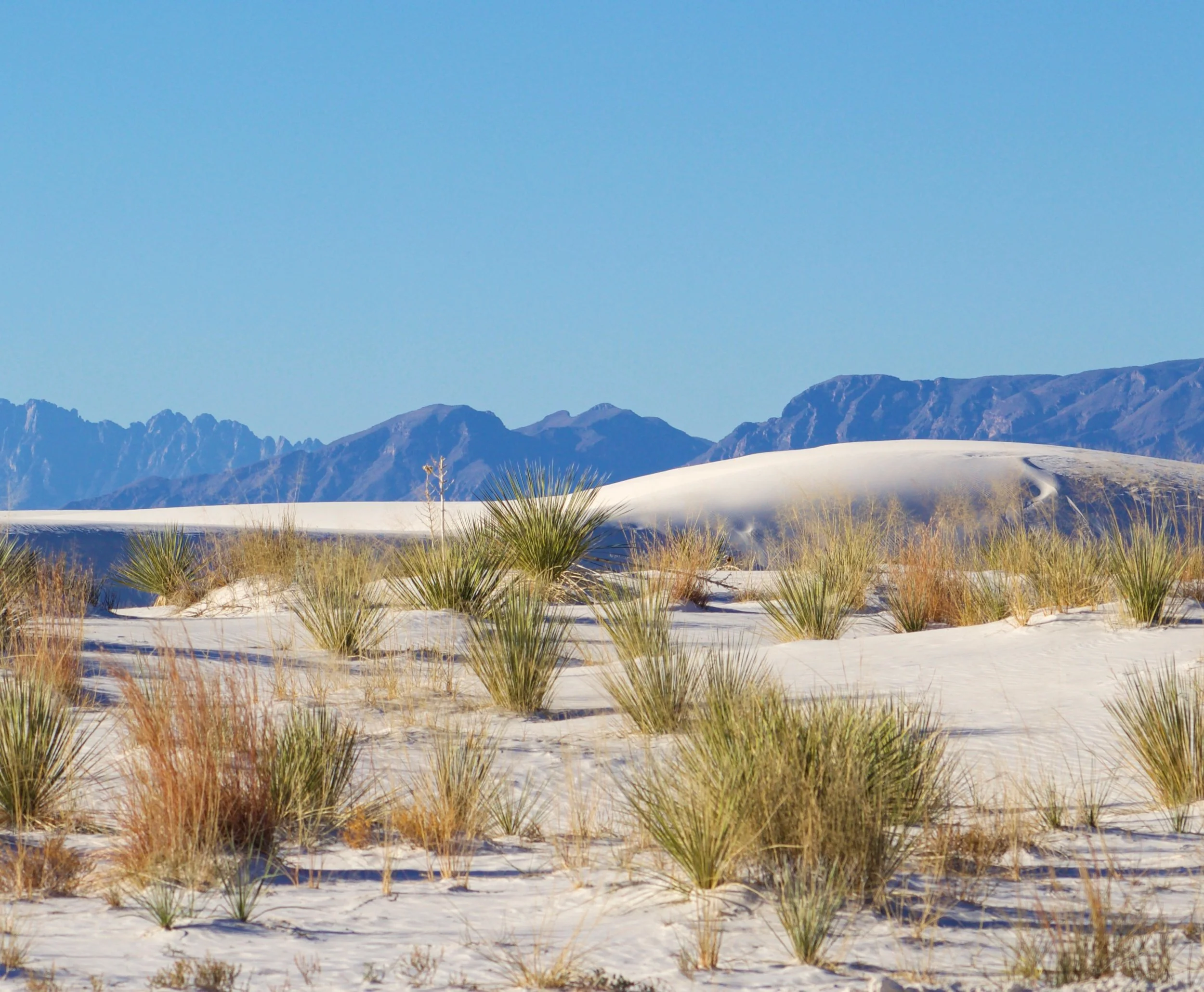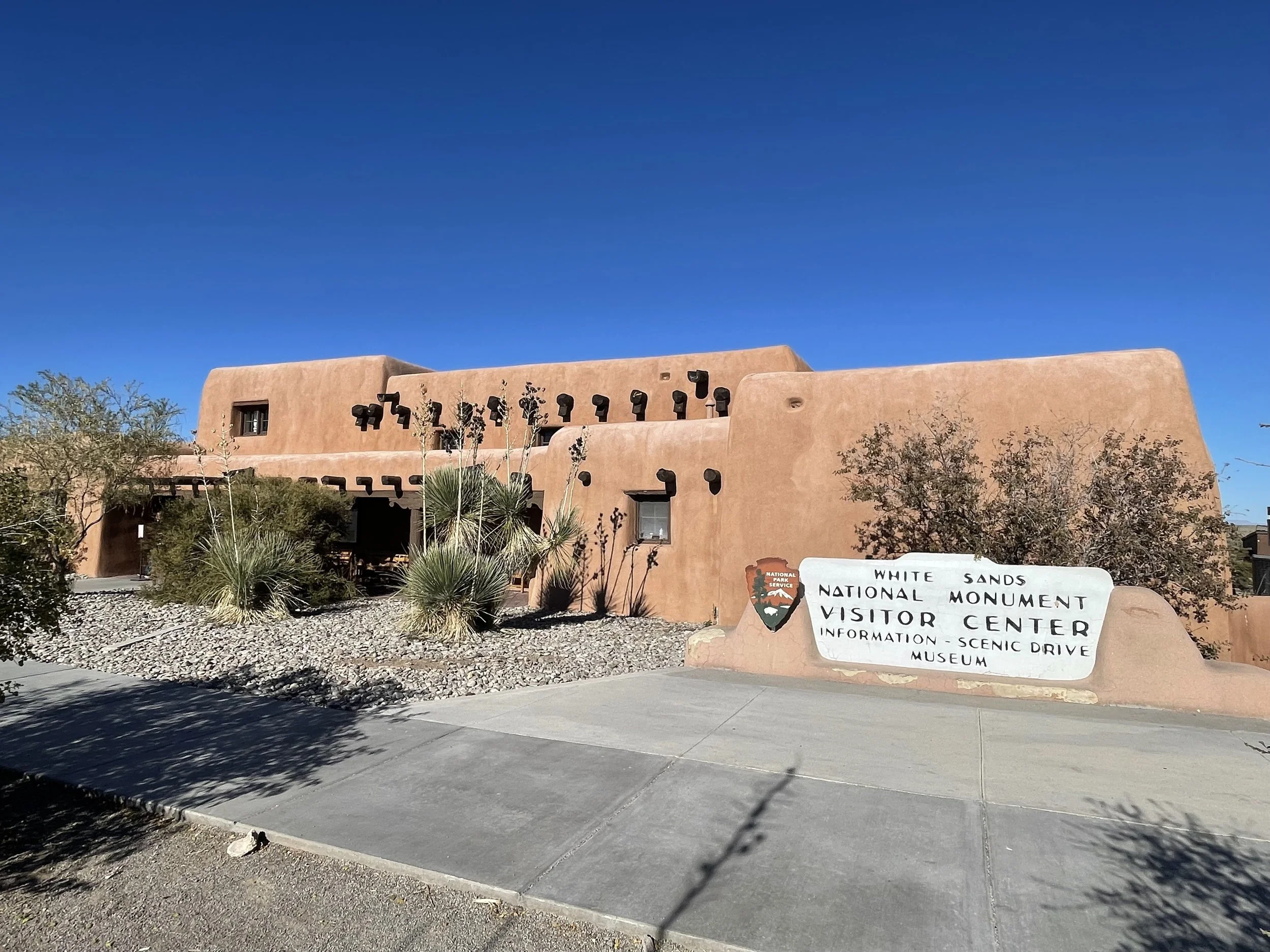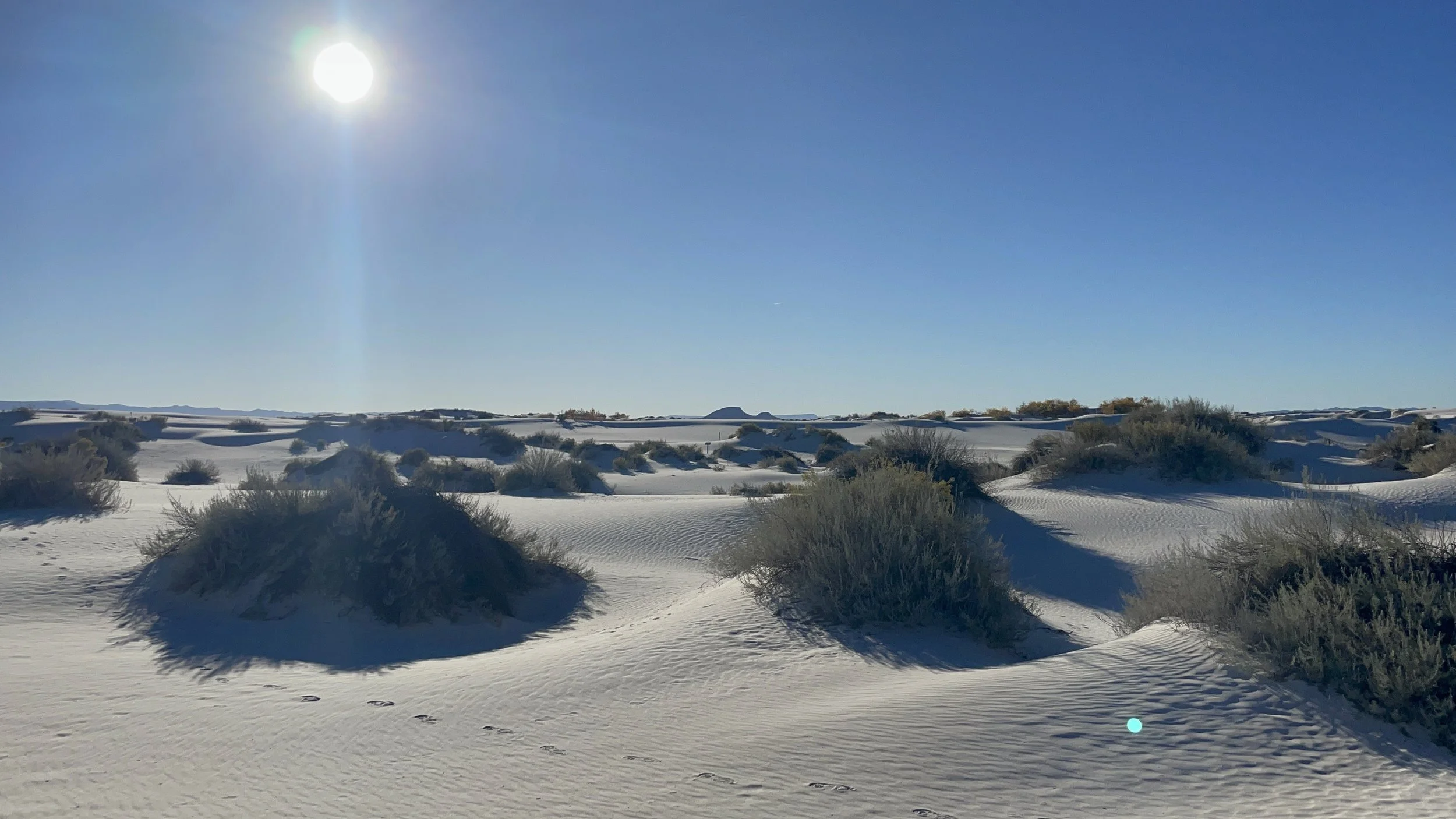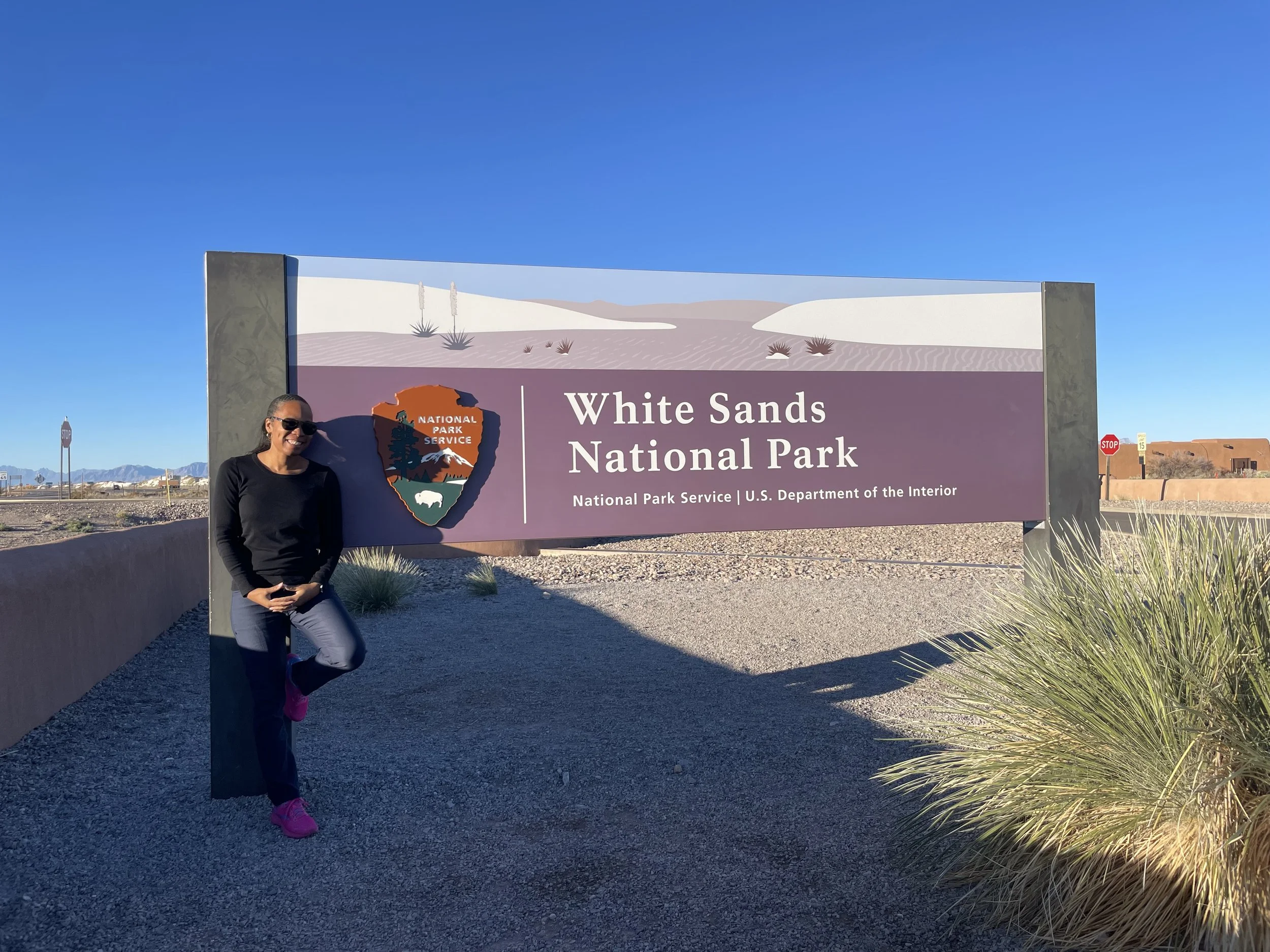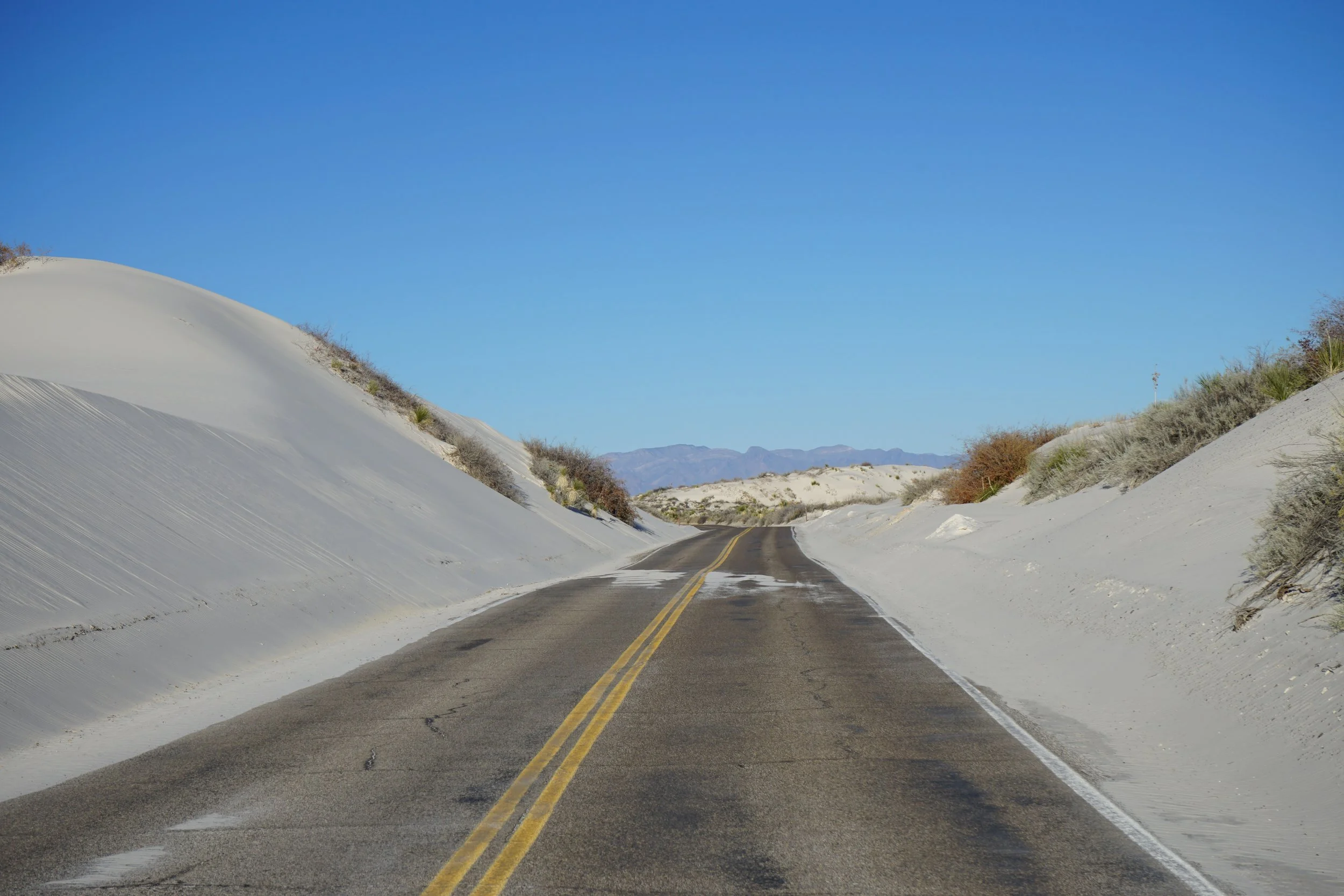#25 White Sands National Park, New Mexico
Visiting White Sands National Park
My journey to White Sands National Park began on a crisp November morning in El Paso, Texas, where I was staying. I drove the 95 miles south on US 54 E toward the park—a scenic trip that took about an hour and a half. I arrived early enough that the Visitor Center was still closed, so after snapping the obligatory photo in front of the iconic National Park sign, I ventured into the park on my own.
Because I got there so early, there were very few people around. I drove the long, winding road, stopping at various parking areas to explore the dunes. The sand was mostly undisturbed in the morning sunlight. The only tracks were the ones I made and a set left behind by a lone hiker who’d walked the trail before me. I stood there for a while, soaking in the vast emptiness. It was calming—almost meditative.
I’ll be honest: while I’ve visited my fair share of sand dunes over the years, I’ve never fully understood the fascination people have with them. Sure, they’re beautiful to look at, but I usually can’t spend more than an hour or so wandering through them. White Sands was no different in that regard.
That said, the sand here is breathtaking. It’s so fine it almost looks like fresh snow, and under the sun it sparkles the way a pristine snowfield would. There’s a certain magic in the way the light dances across the dunes, creating a peaceful atmosphere that made me want to linger just a little longer than usual. As the sun rose higher in the sky, I kept exploring the dunes, enjoying the beauty of the ever-changing landscape. Getting there early meant I had the park nearly to myself before the crowds started to arrive—what a treat!
Before heading out, I stopped by the Visitor Center to get my passport stamp—a little souvenir from my visit. National Park number 25—done!
For those curious: White Sands National Park is located in southern New Mexico and is home to the world’s largest gypsum dune field. The park spans over 275 square miles of glistening white sand, creating an almost otherworldly atmosphere. Unlike typical beach sand, the sand here is made of gypsum crystals, which stay cooler to the touch—even during the hotter months.
The dunes are constantly shifting with the wind, always reshaping the landscape. Besides offering stunning scenery, White Sands is a haven for outdoor activities like hiking, picnicking, and sand sledding. The Visitor Center has educational exhibits covering the area’s geology, wildlife, and history, and there are several trails and scenic drives that let you fully immerse yourself in this beautiful desert environment.
If you’re into wildlife, you’ll also find plenty to observe here. The park is home to various birds, reptiles, and small mammals, all specially adapted to this unique setting.
White Sands Visitor Center
Visitor Center
White Sands Visitor Center:
19955 Highway 70 WestAlamogordo, NM 88310
Hours:
The visitor center is typically open daily from 9:00 AM to 4:30 PM, except on Christmas Day (December 25th) when it’s closed.
Hours may change seasonally, so it’s always a good idea to check the official website before your visit.
Location: The visitor center is conveniently located at the park entrance, where you can grab maps, learn about the park's history, and buy passes.
Park Fees
Entrance Fee:
$25 per vehicle for a 7-day pass (up to 4 adults).
$20 per motorcycle.
$10 per individual (for pedestrians, cyclists, or anyone using non-motorized transport).
Annual Pass: For those planning to visit more than once, the $45 Annual Pass gives you unlimited access for a full year.
Tip: The National Park Service offers free entry days during special events, like National Public Lands Day and Martin Luther King Jr. Day—check their website for specific dates.
Things to Do at White Sands National Park
1. Explore the Dunes
Hiking: The park has several trails to explore the dunes, including:
Interdune Boardwalk: A short and accessible boardwalk that gives you an elevated view of the dunes.
Alkali Flat Trail: A 5-mile round-trip hike that takes you deep into the dunes for incredible views and solitude.
Sand Sledding: Bring your own sled or rent one from the Visitor Center to zoom down the dunes for a fun and thrilling experience.
2. Scenic Drive
Dunes Drive: This 16-mile, one-way road offers sweeping views of the dunes, with several pull-off points where you can stop and take photos or explore the area on foot. It’s a great way to take in the park’s beauty if you’re short on time.
3. Picnicking
There are picnic areas near the entrance, perfect for a break. Some spots offer shaded seating, and others provide a quieter place to enjoy your lunch surrounded by the dunes.
4. Wildlife Watching
White Sands is home to a variety of desert wildlife. Look out for horned lizards, kangaroo rats, and birds like the burrowing owl. Early mornings and evenings are the best times to spot wildlife, as it’s cooler, and animals are more active. Unfortunately I didn’t see much wildlife during my visit
5. Photography & Stargazing
The park offers amazing photo opportunities, especially at sunrise and sunset when the dunes glow with soft light. It’s also a fantastic spot for stargazing due to the minimal light pollution, giving you a clear view of the night sky.
6. Visitor Center Exhibits
The Visitor Center has exhibits that teach visitors about the park's geology, flora, fauna, and the history behind this stunning landscape. The center also features a small gift shop where you can pick up souvenirs, books, and educational materials.
Best Time to Visit
Spring and Fall offer the most comfortable temperatures for exploring the park. Summer can get quite hot, with temperatures often exceeding 100°F (38°C). Winter is cooler, but still mild compared to other regions of the U.S.
Sunrise and Sunset: These times are especially beautiful at White Sands, as the soft light creates a peaceful atmosphere over the dunes.
Tips for Visitors
Bring plenty of water: The desert can get very hot, so staying hydrated is key, especially in summer.
Wear sunscreen and a hat: The sun can be intense, and the white sand reflects sunlight, so make sure you’re protected.
Sturdy shoes: The sand can be soft and deep, so comfortable shoes are a must, especially for hiking.
Check the weather: Occasionally, the winds pick up, so be sure to check the forecast before your visit.
Pets: Pets are welcome, but they must be on a leash and aren’t allowed on trails or in the dunes.

